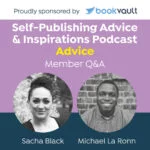
Photo by Agence Olloweb on Unsplash
In this #AskALLi blog post, guest blogger David H. Hendrickson, award-winning author and writer of How to Get Your Book into Schools and Double Your Income with Volume Sales, shares his top tips for getting your indie books into schools.
This post covers a wide range of advice, from how to make contact with schools to promotional options, timings and discounts.
How can you get your indie book into schools?
Have you ever dreamed about getting your books into schools? Ever wondered how to do it? Read on, my friend. What follows are the most important highlights from my books and personal experience.
Getting your book into decision-makers’ hands
Perhaps you simply want to get your book on a school’s recommended reading list. That’s great. Perhaps instead you want to convince a school to buy copies of your book for all its students. That’s even better, far better actually, so I’ll focus considerable attention on the extra requirements this “home run” entails.
Either way, you need to get your book into the hands of schools’ decision makers. How to do that? Unless you’re willing to trust word of mouth to do your work for you—and I’ve enjoyed a wonderful success story in that regard—you’ll need to take the more proactive approach of a marketing campaign.
Yeah, that ugly word marketing. Perhaps you view yourself as an artist and feel that moneygrubbing marketing is beneath you. If so, ask yourself this question: do you want students reading your book or not?
I advocate a direct mail campaign to teachers. A lot of them will throw your flier in the trash. That’s the nature of the beast. But you’ll have invested little—perhaps less than a dollar per school—and if you’ve done it right, enough will respond because your book has caught their attention.
First off, it needs to be the right book.
Put yourself in the teachers’ and principals’ shoes. What does your book do for them and their students? When Lynn English High School selected my novel Offside for its entire student body, the teachers were attracted, among other things, to the themes of bullying, racial problems, family dysfunction, and friendships. They also praised Offside for being a fast-paced book that included a lot of sports to keep their less dedicated readers interested.
Is your book the right book?
Contact information and campaign size
The first thing you need is contact information. At high-schools.com, you can download the physical addresses of all 34,000 United States public and more than 9,000 private high schools and junior high schools for eighty dollars. Alternatively, it costs ten dollars for part of a state, twenty for an entire state, plus five dollars for each additional state. There is also a separate elementary school option. (For my novels, I add a line to this contact information specifying “English Department” so it’s likely to get routed to my target teacher or department head.)
Different countries will offer similar data options. So do your research and find a trusted source for school data to support your markting activity.
How many schools should you contact? Every last one in the universe may be your instinctive response, but you need to keep your campaign size manageable. Believe it or not, too much success can be a problem. Convincing multiple large schools to buy copies for every single student may seem like a dream come true, and in the long run it will be.
In the short term, however, there’s a little old problem called cash flow. Here is how things work after a school decides—cue up the Hallelujah Chorus!—to adopt your book for all its so-very-fortunate students. The school gives you a purchase order. You order the books from Kindle Direct Publishing (KDP), IngramSpark, or some other vendor. It prints and dropships them, then you invoice the school for the books delivered. At some point after that—keep in mind the wheels of government (or other comparable businesses) grind slowly—you get paid.
From the time you order those books, paying out of your own pocket, to when the check arrives in the mail, you sweat financial bullets. For several months. Plan on at least three. (After which, your bank may add insult to injury by putting a partial hold on the check until it clears because of its size.) You can specify on your invoice that the terms are net thirty days, but a government yawns at that. And forget trying to assess late fees. It’s just how the system works.
Using one large high school as an example, I paid over nine thousand dollars for the books and waited a quite-typical three months for payment. The final payday (monetary and otherwise) was handsome indeed, but if nine thousand dollars out of pocket for three months isn’t a big deal to you, you’re in a different tax bracket than I am. There are creative ways to address this short of contacting your local loan shark, but you need to be prepared.
So if contacting every school in the universe suddenly seems ill-advised, what’s the sweet spot? Your response rate will depend on a number of factors, most notably the quality of your promotional materials, which we’ll get to shortly. For now, though, let’s assume you produced a flier with quality content, a professional look, and it’s for a book teachers have a good reason to consider. There’s still an element of luck. That said, for direct mail in general, a response rate of one to two percent is considered good. In my own case, I’ll typically target three hundred schools and generate requests from slightly more than three percent of them.
For your first campaign, I suggest a staggered approach. Send your promotional materials to a quarter of the number of schools you think you’ll eventually contact. (So if you’re going to target two hundred schools, start out with fifty.) Then wait two weeks and adjust depending on the feedback.
Promotional materials for schools

Photo by Agence Olloweb on Unsplash
Armed with the addresses of those schools, you (or your book cover designer) need to create the promotional materials you intend to send. Make them eye-catching, easy to read, and professional in every way. I suggest limiting them to three pages, preferably only one or two.
Beneath a catchy headline, include a large cover image of your book. Preferably in color. Yes, you can save money going black-and-white, but your campaign will live and die based on your ability to catch the teacher’s eye. Color images help you with that. The text will be the pull quotes or the active sales copy you already use to sell the book on your own or retailer websites.
I don’t pretend to be perfect, but you can see my own two-page flyer on the “Web Supplements” page at www.pentpub.com. As in my example, you’ll want to use two or three inches of vertical space on the bottom of the page (or one of the pages if you’ve got more than one) to provide directions for ordering a review copy. Typically, this will be a “Preview Copy Request” form on your publisher website that requires the school name, address, and a contact name and email address.
Review copies for schools
What happens when a teacher requests a review copy? You should immediately reply with a professional email, ideally from your publishing company. Not your private email. Even if in your heart of hearts you’re afraid you just might be small potatoes, don’t spew that nonsense to the teachers you’re trying to impress. You’re impressive, not small potatoes, and you’ve written the perfect book for this teacher! Act like an impressive professional at an impressive, up-and-coming indie publishing company. If necessary, fake it till you make it.
If you’re trying to minimize cost, you can make your review copies electronic and distribute them via an outlet like bookfunnel.com. Simply point the teacher to the download in your email. This is also an ideal approach if the response to your campaign turns out to be so overwhelming you can’t afford the print cost. As long as your promotional materials specified only “a review copy,” you’ll have that flexibility.
I, however, suggest sending both an electronic and a print copy for any teacher requesting a title. As soon as I get a teacher’s request, my publishing company’s email responds with the eBook download information and a promise that a print copy is on its way (which will, of course, also include a professional letter).
Why send both? Enthusiasm is valuable and I want to make the most of it. If a teacher is sufficiently enthusiastic about my book to request a review copy, I want to provide the eBook instantly and the print copy as soon as possible. (You will, of course, be sure to have sufficient copies on hand.)
If you’ve looked at my promotional materials, you’ll see that I promote two books. That means that the cost for both print copies with shipping could approach fifteen dollars. With my typical response rate, a campaign targeting three hundred schools would generate ten requests, almost all for both books. So we’re talking about a hundred fifty dollars.
Too high a cost? Wrong attitude! It’s an investment!
I believe in my books. I’m willing to bet on them—invest in them—to put them into decision makers’ hands. And I’m going to put my best foot forward.
Will there be some freeloaders who go after preview copies simply to stock up the school library (or to sell on eBay)? I haven’t noticed any such eBay activity, and if the worst thing that happens is my books are in school libraries, then sign me up.
As I said before, I believe in my books. You should believe in yours. Some campaigns may cost you a couple hundred dollars and bear no fruit. Others, however, could see you hit the jackpot.

Photo by Jeffrey Hamilton on Unsplash
Timing, discounts, and delivery when getting your indie book into schools
Most campaigns are based on the hope a school will adopt a book for its students to read during the upcoming summer or at least place it on a Summer Recommended Reading list. The latter is, of course, much more flexible because there’s no deadline for getting the books physically inside the school. So let’s assume the more difficult but far more rewarding case of a school purchasing the copies.
A self-imposed books-inside-the-school deadline will vary greatly from one country or state to another (and more so for private schools), but let’s go with everyone’s favorite US deadline, April 15. That’s roughly one month before a state such as Florida lets out for the summer. Adjust as you deem appropriate and to match local dates (for example in the UK you may be looking at a May/June deadline instead), but cut it too close to the end of the school year and you’re asking for trouble.
Do you really want to risk the books arriving the day after the last day of school? Do you want to see a good chunk of your profit disappear if you have to pay potentially hundreds of dollars more for expedited shipping? Or two thousand dollars for priority shipping?
There’s also the matter of volume discounts and reduced shipping costs. KDP has regrettably eliminated volume discounts for author copies. The price is no different whether you order one copy or 999. Boo! And that 999 number is also the maximum order allowed. Another boo! Fortunately, if you need more copies that that, you need only wait twenty-four hours to make a follow-up order of up to 999 books.
As for IngramSpark, volume discounts remain possible for orders of at least 750 copies, which qualify for “Extended Service,” an option that dramatically drives down the cost. That’s the good news. The bad news is that this option “usually prints in 60 business days.” As a result, you’ll need to move up your deadlines by two months to qualify and if you’re like me, that “usually” word may keep you up late at night.
Even if you’re opting out of IngramSpark’s Extended Service, an April 15 books-inside-the-school deadline becomes a March 15 purchase-order-in-hand deadline since you can’t order the books without a purchase order. Always allow sufficient leeway for something to go wrong so you don’t snatch defeat out of the jaws of victory.
When to get started selling-in to schools
Working backward from your delivery date, I’ve seen it take almost two months from budget approval to seeing a purchase order. And although I haven’t been privy to these particular conversations, I can imagine that a month or two could easily elapse from a teacher’s recommendation until budget approval.
All of which means that running your campaign after New Year’s runs the major risk of failing or at least resulting in a “wait till next year” outcome. Add in that December is historically the worst time for direct mail campaigns (due to all the holiday circulars) as well as the chaos of the opening of a new school year in early September, and the process of elimination tells you what to do.
October and November is the clear “sweet spot” for running your campaign. That gives your teacher time to evaluate your book, fall in love with it, and get the bureaucratic ball of red tape rolling.
Hey, check out the calendar! This blog post is going live in July, just the right time to start getting your own ball rolling toward the satisfaction and reward of getting your book into schools.
I wish you the best of luck!
Who is David H. Hendrickson?
David H. Hendrickson is a fiction and non-fiction writer, with top titles including How to Get Your Book into Schools and Double Your Income with Volume Sales, and Travis Roy: Quadriplegia and a Life of Purpose, among many others.
David has been honored with the Joe Concannon Hockey East Media Award and the Murray Kramer Scarlet Quill Award and his novel Offside has been adapted for high school student required reading. Find out more on David's website, or follow David on Facebook: facebook.com/davewrites, X: @DHWriter, or Instagram: @dhwriter7.
Find out more:
If you write YA or middle-grade fiction, you can catch up on a recent ALLi podcast exploring marketing tips.
Sacha Black and Micheal La Ronn discuss tips including how to target parents alongside children, on the #ALLi podcast: Marketing Middle-Grade Fiction
Thoughts or further questions on this post or any self-publishing issue?
 If you’re an ALLi member, head over to the SelfPubConnect forum for support from our experienced community of indie authors, advisors, and our own ALLi team. Simply create an account (if you haven’t already) to request to join the forum and get going.
If you’re an ALLi member, head over to the SelfPubConnect forum for support from our experienced community of indie authors, advisors, and our own ALLi team. Simply create an account (if you haven’t already) to request to join the forum and get going.
Non-members looking for more information can search our extensive archive of blog posts and podcast episodes packed with tips and advice at ALLi's Self-Publishing Advice Centre.





